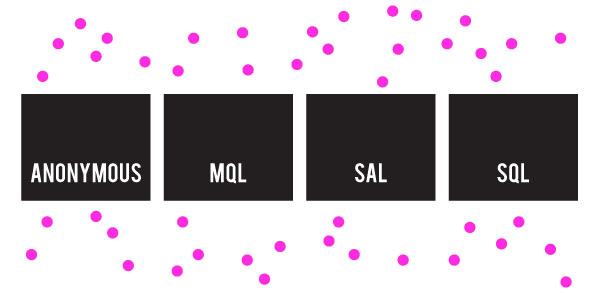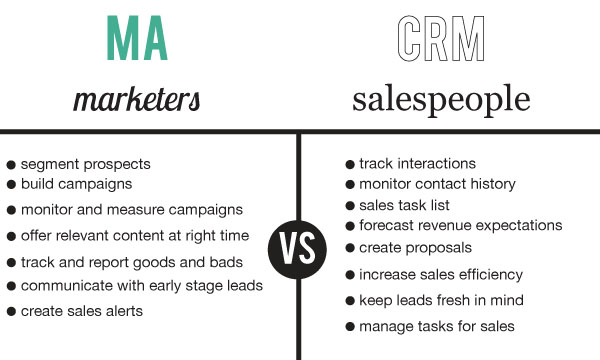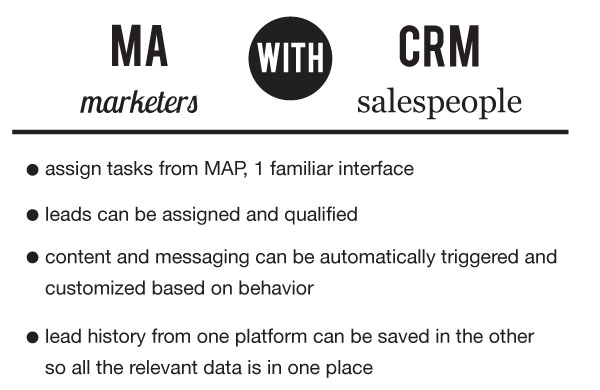Marketing Automation Platforms (MAPs) and CRM Systems are like Calvin and Hobbes: they’re better together. Each is great on their own, but together they’re an unbeatable force. A robust CRM integration isn’t just a “want” in a MAP, it’s a need.
Why You Need the Integration
Break down the silos! Align marketing and sales! Time out. How do you do that?! Before you take a sledgehammer to the office walls, you should consider common goals between both teams. Both teams want an increase in quality leads to help generate more revenue for the company. Once you’ve defined lead stages and what qualifies as a quality lead, marketing and sales can get on the same page. Then you’re ready for some software collaboration. Start with an integration between the MAP your marketing team is using and the CRM system your sales team is using. How does an integration help close the gap between marketing and sales? By using software tools that coexist and work together, you create synergies within your marketing and sales teams. Each team continues to use the tools they’re already familiar with, but through the integration new insights can be gained and both teams can leverage the shared knowledge to fulfill their common goals. Boom. Marketing and sales are working together.

The Basics of CRM systems and MA platforms
Marketing Automation is a technology platform focused on lead management for prospects in the top and middle of the funnel. The technology was built to eliminate the missing link between someone who downloads an asset on your website and someone who is ready to buy and should be talking to sales. That transition is the step between a Marketing Qualified Lead (MQL) and Sales Qualified Lead (SQL). In many B2B organizations with long sales cycles there is a vast difference between MQL and SQL, and the MQL needs to be nurtured, scored and measured before they are qualified to be handed off to sales. All of the nurturing, scoring, measuring and handing off happens in the MAP.
Marketing automation includes triggers, processes and executions that touch prospects in the MQL stage of the buying cycle. They hopefully will progress to the Sales Accepted Lead (SAL) stage, where communication can be taken over by sales. Sales will generally utilize their CRM system to take the lead to a completed sale.
CRM systems were originally created to help salespeople. At a simple level they are a complex database meant to help sales teams keep track of customers or leads. They include functionality for creating tasks and follow-up records, building proposals and forecasts, and monitoring communication. They generally track opportunities at the account or organization level, and not as much on the personal level that MAPs function at.
There is much more to both software tools, but that should provide some overview of these two powerful and important systems. In summary:

Marketing Automation helps marketing teams by allowing them to:
-
segment prospects by whatever criteria you wish to trigger communication
-
build multi-channel, multi-touch campaigns
-
monitor and measure the effect their campaigns are having on lead stages
-
offer relevant content the right prospects at the right time in the buying cycle
-
track and report on their successes and failures
-
communicate in a valuable way with early stage leads
-
set alerts for Sales that are triggered by buy-ready activities
CRM systems help sales teams by allowing them to:
-
keep track of lead information and interactions
-
monitor and organize a lead’s history and interests
-
keep sales teams on task
-
forecast monthly, quarterly and annual revenue expectations by account, salesperson, region, etc.
-
create proposals
-
Increase the efficiency of a sales force
-
keep leads fresh in the minds of salespeople
-
schedule, create and manage tasks to do by sales people
The Power and the Synergy of a Solid Integration
Both platforms help organizations become more profitable and increase efficiency, but when CRM systems and MAPs work together that level of efficiency increases exponentially. Sales and marketing working together to interact with leads in all stages of the buying cycle, from Anonymous to Sales Qualified all the way to a purchase decision. Think about that for a moment. Marketing and Sales working together on messaging, segmenting, lead stages, scoring rules, lead handoff processes, etc. is a massively powerful thing. No longer is there finger pointing between the two groups that the other doesn’t “get it”. Now, both groups are working together, through technology at a minimum, with visibility into their prospects throughout the entire buying journey. The payoff and returns are incredible.

Integrated MAPs and CRM systems help both sales and marketing teams:
-
Assign CRM tasks from the MAP. One familiar interface, cross-communication, efficiency defined. More on this below* this list.
-
Leads can be assigned and qualified to an appropriate nurture campaign or a sales representative, depending on qualifying criteria such as geographical region, company size, vertical or any user-defined criteria.
-
Content and messaging can be automatically triggered and customized based on lead activities and behavior.
-
Lead activity history from the MAP is integrated into the CRM record so the salesperson can see all relevant data of both platforms in one system.
Increase Efficiency and Coordinate Across Teams
*One hugely important capability you gain with integrated systems is efficient task management. I mentioned above that you can assign CRM tasks from your MAP, but there is a lot that this encompasses, so I feel obliged to elaborate here. Imagine you have a lead from Acme who downloads some content and then signs up for a demo. This is essentially that lead engaging with your company and asking to be contacted by sales with more information about how the product works. You can assign Joe the sales guy to call Acme when they request a demo because you know Joe owns that lead, lives in the same region and has already spoken with the lead before. Joe gets back from lunch and sees a task assigned to him. He calls Acme. Acme is happy, the marketing team is happy, managers in sales and marketing are happy, and Joe is happy. Notice that Joe has one interface within his CRM system so he doesn’t need to spend any time learning how to use the MA software that marketing interfaces with. This makes cross-communication easy and efficient.
The Value of the Integration
Sales and marketing can work together painlessly with well-integrated systems, but prepare for inefficiency if that integration is non-existent or executed poorly. I’m not just talking about time lost during training, I’m talking about regularly missing out on recurring revenue opportunities as a result of a lack of communication, a disparity in understanding and process inefficiencies.
When both CRM systems and marketing automation platforms communicate with each other, your multiple teams turn into one team with varied skill sets and the same goals in mind: get more quality leads and increase revenue. If you’re not integrating your CRM with your MAP you need to change that now. If you are integrated what benefits have you noticed?

